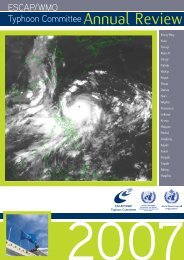TCAR - Typhoon Committee
TCAR - Typhoon Committee
TCAR - Typhoon Committee
Create successful ePaper yourself
Turn your PDF publications into a flip-book with our unique Google optimized e-Paper software.
<strong>TCAR</strong><br />
CHAPTER 5 - RESEARCH FELLOWSHIP TECHNICAL REPORT<br />
as the number of samples dropped rapidly at longer<br />
forecast range (Fig. 1).<br />
Besides, the calibrated intensity forecasts were still not<br />
quite able to forecast the rapid change of TC intensity<br />
(both deepening or weakening) as evident in Fig. 4(a)<br />
and (b).This could be attributed to model limitations in<br />
adequately resolving the TC structure with a coarse<br />
grid spacing of 1.125 degrees (i.e. around 120 km).<br />
5. Probabilistic approach<br />
A suite of methods have since been developed<br />
for calibrating probability forecasts derived from<br />
ensemble systems, such as multiple implementation<br />
of single-integration MOS equations (Erickson, 1996),<br />
ensemble dressing (Roulston and Smith, 2003) € and<br />
logistic regression methods (Hamill et al. 2004).<br />
Hamill and Colucci (1997, 1998) described a rank<br />
histogram calibration based on the reliability of past<br />
forecasts.This method has been applied to temperature<br />
and precipitation forecasting.In this study, the same<br />
approach was tested to post-process the probability<br />
forecast of TC intensity category, according to the<br />
following classification:<br />
• Low system (LOW) – maximum wind < 22 kt<br />
• Tropical Depression (TD) – 22 kt ≤ maximum<br />
wind < 34 kt<br />
• Tropical Storm (TS) – 34 kt ≤ maximum wind <<br />
48 kt<br />
• Severe Tropical Storm (STS) – 48 kt ≤ maximum<br />
wind < 64 kt<br />
• <strong>Typhoon</strong> (TY) – 64 kt ≤ maximum wind<br />
In view of the lack of samples and relatively<br />
unsatisfactory performance of the calibrated intensity<br />
forecasts in the longer forecast range as discussed<br />
in Section 4, probability forecasts as explored in this<br />
study will be confined to the first 120 hours.<br />
a. Methodology<br />
The rank histogram calibration method can be divided<br />
into two steps: bias correction and calibration.<br />
1) Bias correction<br />
Before constructing the rank histogram, each member<br />
forecast was first de-biased to remove any systematic<br />
errors in the maximum wind forecasts.Two different<br />
methods have been tested.The first method was<br />
simple bias removal.The correction (corr) to be made<br />
was determined as follows:<br />
……………….(1)<br />
where i is the forecast range (6, 12, ......, 120-h), n<br />
the number of samples, OBSW the BT maximum wind<br />
speed and EMW the ensemble mean of the maximum<br />
wind speed.<br />
Another method<br />
n<br />
corr was to correct all<br />
i = ∑(OBSWi,<br />
j − EMWi, j )<br />
j =1<br />
member forecasts<br />
using the ANN<br />
approach described in Section 4.The mean errors<br />
of the direct EPS outputs and the corrected member<br />
forecasts in 2005 are plotted in Fig. 5.<br />
The mean errors after correction using both methods<br />
described above are much reduced, falling within -5<br />
to +5 kt for the whole forecast range.<br />
Fig. 5 - The mean errors of the maximum wind speed<br />
forecasts in 2005.DMO: the maximum wind speed as<br />
derived from the direct EPS outputs; ANN: correction<br />
by ANN described in Section 4; and SBR: correction<br />
by simple bias removal.<br />
2)Calibration<br />
The bias correction described above effectively<br />
removed the systematic biases but the corrected<br />
probability forecasts might still not be reliable.<br />
Following Hamill and Colucci (1997), the probability<br />
distribution was calibrated using the verification rank<br />
histogram.The rank histogram consisting of 24 bins<br />
de-limited by the 25 members’ forecasts of maximum<br />
wind were sorted in numerical order, with two<br />
2009<br />
273

















